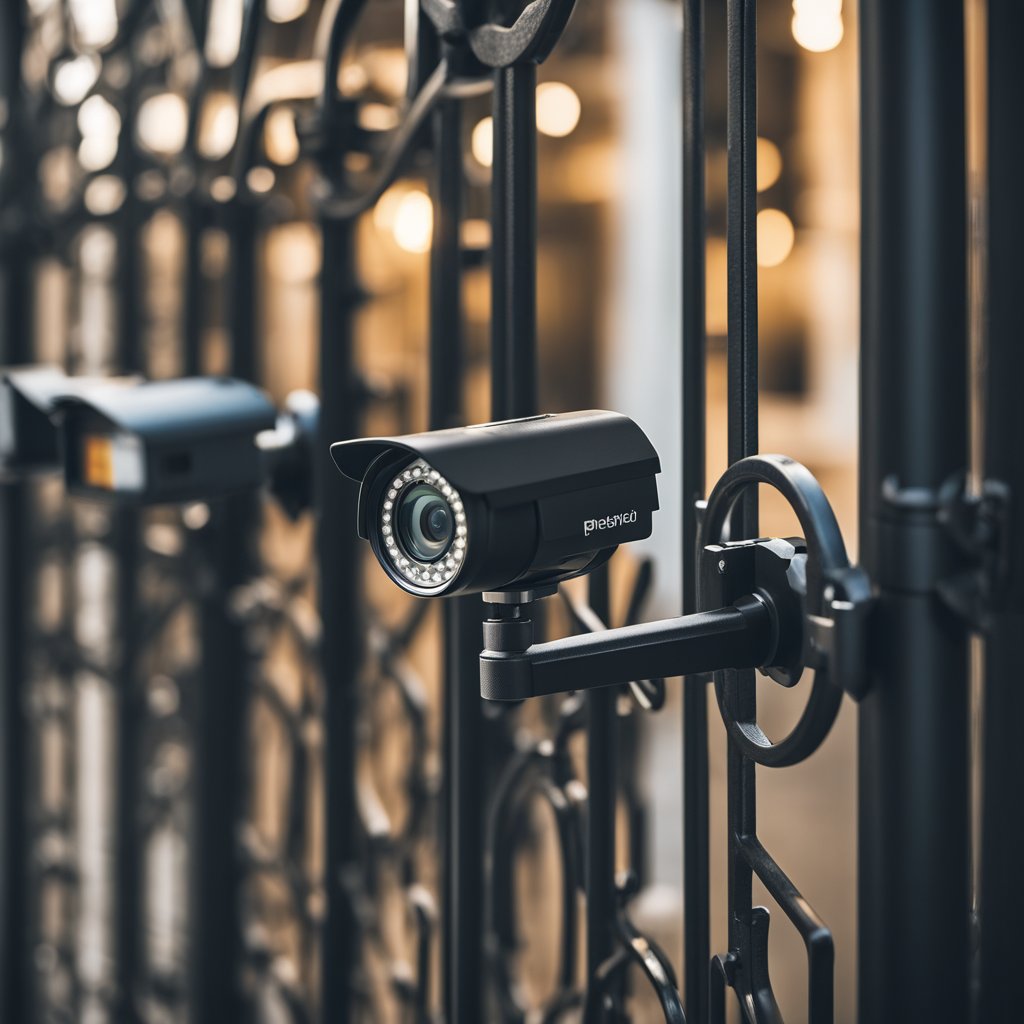Understanding IoT Security: Best Practices to Protect Your Devices
If you’re reading this article, you likely have an IoT device in your home or office. The Internet of Things (IoT) is changing the way we live and work, but it also presents new security challenges. IoT devices are vulnerable to cyber attacks, and if they are not properly secured, they can be used to launch attacks on other devices or networks. In this article, we will explore the best practices for IoT security to help you protect your devices and data.

The importance of IoT security cannot be overstated. IoT devices are everywhere, from smart thermostats and security cameras to industrial control systems and medical devices. These devices are connected to the internet, which means they are vulnerable to cyber attacks. A single vulnerable device can be used to launch a chain reaction of attacks that can compromise an entire network. Understanding IoT security is critical to protecting your devices and data.
To help you better understand IoT security, we will explore the various components of IoT ecosystems, common IoT security threats, IoT security frameworks and standards, best practices for device security, network security strategies, data protection and privacy, incident response planning, IoT security tools and solutions, future trends in IoT security, and creating a culture of security. By the end of this article, you will have a better understanding of how to protect your IoT devices and data from cyber threats.
Key Takeaways
- Protecting your IoT devices and data is critical in today’s connected world.
- Understanding the components of IoT ecosystems and common security threats is essential for securing your devices.
- Implementing best practices for device security, network security strategies, and incident response planning can help you protect your devices and data from cyber attacks.
The Importance of IoT Security

You may not realize it, but the devices you use every day, such as your phone, laptop, and even your refrigerator, could be part of the Internet of Things (IoT). These devices are connected to the internet and can communicate with each other, making our lives more convenient. However, this convenience comes at a cost – the security of these devices.
IoT security is critical because these devices collect and transmit sensitive information, such as personal data, financial information, and even physical location. If this information falls into the wrong hands, it could lead to identity theft, financial loss, or even physical harm. Therefore, it is essential to understand the importance of IoT security and take steps to protect your devices.
One of the best practices for IoT security is to keep your devices up-to-date with the latest security patches and firmware updates. These updates are released regularly to fix security vulnerabilities that could be exploited by hackers. By keeping your devices up-to-date, you can minimize the risk of a security breach.
Another best practice for IoT security is to change the default passwords on your devices. Default passwords are often easy to guess and can be found on the internet, making it easy for hackers to gain access to your devices. By changing the default passwords, you can make it more difficult for hackers to gain access to your devices.
In summary, the importance of IoT security cannot be overstated. Your devices are collecting and transmitting sensitive information, and it is your responsibility to protect them. By keeping your devices up-to-date and changing default passwords, you can minimize the risk of a security breach.
Understanding IoT Ecosystems

When it comes to securing your IoT devices, it’s important to understand the different layers of the IoT ecosystem. The three main layers are the device layer, network layer, and application layer.
Device Layer
At the device layer, it’s important to consider the physical security of your devices. This includes things like ensuring that only authorized personnel have access to your devices and that your devices are physically secured from theft or tampering. Additionally, it’s important to keep your devices up to date with the latest security patches and firmware updates to protect against known vulnerabilities.
Network Layer
The network layer is where your devices communicate with each other and with the internet. To secure your network layer, you should ensure that your network is properly segmented and that your devices are only able to communicate with authorized devices. Additionally, you should use strong encryption protocols to protect your data in transit and ensure that your network is protected by a strong firewall.
Application Layer
The application layer is where your devices interact with the software and services that make up your IoT ecosystem. To secure your application layer, you should ensure that your software and services are properly configured and that they are only accessible to authorized users. Additionally, you should use strong authentication and access control mechanisms to protect against unauthorized access to your applications and data.
Overall, understanding the different layers of the IoT ecosystem is essential to securing your IoT devices. By taking a holistic approach to security and addressing vulnerabilities at each layer, you can ensure that your devices are protected from both physical and digital threats.
Common IoT Security Threats

As the number of IoT devices continues to grow, so does the risk of security threats. In this section, we will discuss the most common types of IoT security threats and how to protect against them.
Physical Attacks
Physical attacks are a type of IoT security threat that involves physical access to the device. This can include theft, tampering, or destruction of the device. Physical attacks can compromise the security of the device and the data it contains.
To protect against physical attacks, it is important to keep the device in a secure location and limit access to authorized personnel only. Additionally, implementing security features such as tamper-proof seals and alarms can help to deter physical attacks.
Network Attacks
Network attacks are a type of IoT security threat that involves unauthorized access to the device through the network. This can include hacking, phishing, and malware attacks. Network attacks can compromise the security of the device and the data it contains.
To protect against network attacks, it is important to implement strong network security measures such as firewalls, VPNs, and encryption. Additionally, it is important to keep the device software up-to-date with the latest security patches and to use strong passwords.
Software Vulnerabilities
Software vulnerabilities are a type of IoT security threat that involves weaknesses in the device software. This can include bugs, backdoors, and other vulnerabilities that can be exploited by attackers. Software vulnerabilities can compromise the security of the device and the data it contains.
To protect against software vulnerabilities, it is important to keep the device software up-to-date with the latest security patches. Additionally, it is important to use trusted software sources and to avoid installing software from unknown or untrusted sources.
In summary, protecting against IoT security threats requires a combination of physical security measures, network security measures, and software security measures. By implementing these best practices, you can help to ensure the security of your IoT devices and the data they contain.
IoT Security Frameworks and Standards

When it comes to securing IoT devices, it is essential to have a comprehensive framework and standard in place. These frameworks and standards provide guidelines for manufacturers, developers, and users to ensure that IoT devices are secure and protected from cyber threats.
Industry-Specific Frameworks
Different industries have different security requirements, and therefore, industry-specific frameworks have been developed to address the unique security challenges faced by each industry. For instance, the healthcare industry has the Health Insurance Portability and Accountability Act (HIPAA) Security Rule, which outlines the security standards that must be followed to protect patients’ electronic health information.
In the automotive industry, the Automotive Information Sharing and Analysis Center (Auto-ISAC) has developed a framework that provides guidelines for securing connected vehicles. The framework covers areas such as threat intelligence, incident response, and vulnerability management.
General Security Frameworks
Several general security frameworks have been developed to provide a set of guidelines that can be applied to any industry or sector. One such framework is the National Institute of Standards and Technology (NIST) Cybersecurity Framework. The NIST framework provides a set of standards, guidelines, and best practices to help organizations manage and reduce cybersecurity risk.
Another framework is the International Organization for Standardization (ISO) 27001, which provides a systematic approach to managing sensitive information. The ISO 27001 framework covers areas such as risk assessment, security controls, and incident management.
In conclusion, having a comprehensive IoT security framework and standard is essential to ensure that IoT devices are secure and protected from cyber threats. Industry-specific frameworks and general security frameworks provide guidelines that can be applied to different industries and sectors. By following these frameworks and standards, manufacturers, developers, and users can ensure that IoT devices are secure and protected.
Best Practices for Device Security

Protecting your IoT devices from security threats is a crucial task that requires careful attention to detail. By following best practices, you can reduce the risk of your devices being compromised by attackers. Here are some of the best practices for device security that you should consider:
Secure Booting
Secure booting is a critical component of device security. It ensures that only authorized firmware is loaded during the boot process. This prevents attackers from loading malicious software onto your device. Secure booting relies on digital signatures to verify the authenticity of firmware images. You should only use firmware images that are signed by a trusted source.
Access Controls
Access controls are another essential aspect of device security. They limit the ability of attackers to gain unauthorized access to your device. Access controls can be implemented in several ways, such as using strong passwords, two-factor authentication, and role-based access control. You should also disable any unnecessary services or interfaces to reduce the attack surface of your device.
Regular Updates
Regular updates are critical for maintaining the security of your IoT devices. Updates often include security patches that address known vulnerabilities. You should regularly check for updates and apply them as soon as they become available. You should also ensure that your devices are configured to automatically check for updates.
By following these best practices, you can significantly improve the security of your IoT devices. However, keep in mind that security is an ongoing process. You should regularly review and update your security measures to stay ahead of emerging threats.
Network Security Strategies

As you begin to understand the importance of IoT security, it is essential to consider network security strategies that can help protect your devices against advanced cybersecurity attacks and threats.
Firewalls and Gateways
Firewalls and gateways are essential components of network security. Firewalls act as a barrier between your devices and the internet, blocking unauthorized access and preventing malicious traffic from entering your network. Gateways, on the other hand, help to control the flow of data between your connected devices and the internet. By implementing firewalls and gateways, you can secure your network and protect your devices from potential threats.
Intrusion Detection Systems
Intrusion detection systems (IDS) are another critical component of network security. IDS can detect and alert you to potential security breaches, such as unauthorized access or suspicious behavior on your network. By monitoring your network for potential threats, IDS can help you take proactive steps to prevent security breaches and protect your devices from harm.
Secure Communication Protocols
Secure communication protocols are essential for protecting your devices from cybersecurity threats. These protocols ensure that your devices are communicating with each other securely, without the risk of interception or tampering. By using secure communication protocols, you can ensure that your devices are protected from potential threats, even when communicating over the internet.
In conclusion, implementing network security strategies is crucial for protecting your IoT devices from advanced cybersecurity threats. By using firewalls and gateways, intrusion detection systems, and secure communication protocols, you can secure your network and protect your devices from potential harm.
Data Protection and Privacy

As you connect more devices to the Internet of Things (IoT), it becomes increasingly important to protect your data and privacy. Here are some best practices to follow:
Encryption Techniques
Encryption is the process of converting data into a code that can only be deciphered with a key. This is an effective way to protect your data from being intercepted and read by unauthorized parties. When choosing IoT devices, look for ones that use strong encryption algorithms such as AES or RSA.
Data Anonymization
Data anonymization is the process of removing personally identifiable information from data sets. This can help protect your privacy by making it more difficult for hackers to identify you. When using IoT devices, make sure to read the privacy policy and understand how your data is being used. If you are uncomfortable with the level of data collection, consider using devices that allow you to opt-out of certain data collection practices.
User Consent
User consent is an important aspect of data protection and privacy. Before using an IoT device, make sure to read the terms of service and understand how your data will be used. If you are uncomfortable with the level of data collection, consider using devices that allow you to opt-out of certain data collection practices. Additionally, be wary of devices that require you to provide personal information in order to use them.
By following these best practices, you can help protect your data and privacy while using IoT devices. Remember to always read the privacy policy and understand how your data is being used.
Incident Response Planning

When it comes to IoT security, having a solid incident response plan is crucial. In the event of a security breach, a well-prepared response plan can help minimize damage and prevent future incidents.
Detection and Analysis
The first step in incident response planning is detection and analysis. This involves monitoring your IoT devices for any signs of suspicious activity and analyzing any potential threats. You should have a system in place to alert you when there is a security breach and be able to quickly identify the source of the breach.
Containment and Eradication
Once a security breach has been detected and analyzed, the next step is containment and eradication. This involves isolating the affected devices and preventing the spread of the breach to other devices on the network. You should have a plan in place for how to contain the breach and remove any malware or other malicious code that may be present on the affected devices.
Recovery and Post-Event Analysis
The final step in incident response planning is recovery and post-event analysis. This involves restoring normal operations and analyzing the incident to determine what went wrong and how to prevent similar incidents from occurring in the future. You should have a plan in place for how to recover from a security breach and conduct a thorough post-event analysis to identify any weaknesses in your IoT security strategy.
In summary, incident response planning is an essential component of any IoT security strategy. By having a solid plan in place for detection and analysis, containment and eradication, and recovery and post-event analysis, you can help minimize the impact of a security breach and prevent future incidents from occurring.
IoT Security Tools and Solutions

Protecting your IoT devices from security threats requires a combination of tools and solutions. Here are some of the most effective ones:
Security Assessment Tools
Security assessment tools are designed to identify vulnerabilities in your IoT devices and network. These tools can help you understand the risks associated with your devices and take appropriate measures to mitigate them. Some popular security assessment tools include:
- Nmap: a free and open-source tool for network exploration and security auditing.
- Metasploit: a penetration testing framework that helps you identify and exploit vulnerabilities in your network.
- OpenVAS: a vulnerability scanner that helps you identify security issues in your network and provides recommendations on how to fix them.
Threat Intelligence Platforms
Threat intelligence platforms provide real-time information about security threats and vulnerabilities. These platforms can help you stay up-to-date on the latest security threats and take appropriate measures to protect your IoT devices. Some popular threat intelligence platforms include:
- AlienVault: a cloud-based platform that provides threat intelligence and security management tools.
- FireEye: a threat intelligence platform that provides real-time information about security threats and vulnerabilities.
- Symantec: a threat intelligence platform that provides advanced security solutions to protect your IoT devices.
Integrated Security Solutions
Integrated security solutions provide comprehensive security measures to protect your IoT devices and network. These solutions can help you identify and mitigate security threats in real-time. Some popular integrated security solutions include:
- Cisco IoT Security: a comprehensive security solution that provides real-time threat detection and mitigation.
- IBM Watson IoT Platform: a cloud-based platform that provides advanced security features to protect your IoT devices.
- Microsoft Azure IoT: a cloud-based platform that provides end-to-end security solutions to protect your IoT devices and network.
By using these tools and solutions, you can significantly improve the security of your IoT devices and protect them from potential threats.
Future Trends in IoT Security
As technology advances, the need for more secure IoT devices grows. The following subsections highlight some of the future trends in IoT security.
Advancements in AI
Artificial intelligence (AI) is quickly becoming a popular solution to enhance IoT security. Machine learning algorithms can analyze vast amounts of data and identify potential threats to IoT devices. AI can also be used to detect anomalies in device behavior, making it easier to identify and prevent attacks. As AI continues to evolve, it will become an increasingly important tool in securing IoT devices.
Blockchain for IoT Security
Blockchain technology has the potential to revolutionize IoT security. By using a decentralized ledger, blockchain can provide a secure and tamper-proof record of all transactions, making it difficult for hackers to compromise devices. Blockchain can also be used to securely store sensitive data, such as personal information or financial data. As more companies adopt blockchain for IoT security, it will become a powerful tool in protecting devices from attacks.
Developing Threat Landscape
As the number of IoT devices continues to grow, so does the threat landscape. Hackers are constantly developing new techniques to compromise devices, and it’s important to stay up-to-date on the latest threats. Some of the emerging threats include ransomware attacks, botnets, and supply chain attacks. To protect your IoT devices, it’s essential to stay informed about the latest threats and take proactive steps to secure your devices.
In conclusion, the future of IoT security is constantly evolving, and it’s essential to stay ahead of the curve. By adopting new technologies such as AI and blockchain, and staying informed about the latest threats, you can protect your IoT devices and keep your data secure.
Creating a Culture of Security
To effectively protect your IoT devices, it is essential to create a culture of security within your organization. This culture should prioritize security and encourage all stakeholders to take an active role in safeguarding IoT devices.
Training and Awareness
One of the most critical aspects of creating a culture of security is training and awareness. Your employees must be aware of the potential security risks associated with IoT devices and understand how to identify and respond to security threats. Regular training sessions can help ensure that everyone in your organization is up-to-date with the latest security best practices and protocols.
Security by Design Philosophy
Another crucial element of creating a culture of security is adopting a security-by-design philosophy. This approach involves integrating security considerations into every stage of the IoT device development process. By doing so, you can ensure that security is an integral part of your IoT devices, rather than an afterthought.
Stakeholder Engagement
Finally, engaging with all stakeholders is essential for creating a culture of security. This includes not only your employees but also your partners, suppliers, and customers. By working together, you can ensure that everyone involved in the development, deployment, and use of your IoT devices is aware of the security risks and actively working to mitigate them.
In summary, creating a culture of security is essential for protecting your IoT devices. By prioritizing security, providing regular training and awareness, adopting a security-by-design philosophy, and engaging with all stakeholders, you can ensure that your IoT devices are secure and protected from potential threats.
Frequently Asked Questions
What are the top recommended practices for enhancing IoT device security?
To enhance the security of your IoT devices, it is recommended to follow some best practices. First, always change the default passwords to strong and unique ones. Second, keep the firmware of your devices up-to-date to fix any known vulnerabilities. Third, use encryption protocols such as SSL/TLS to secure the communication between your devices and the internet. Fourth, disable unused features and services to reduce the attack surface of your devices. Fifth, use two-factor authentication to add an extra layer of security to your devices.
How can you protect your IoT devices from potential hacking attempts?
To protect your IoT devices from potential hacking attempts, it is recommended to take some precautions. First, avoid connecting your devices to public Wi-Fi networks or untrusted networks. Second, enable the firewall on your home network to block unauthorized access to your devices. Third, use a VPN to encrypt your internet traffic and protect your privacy. Fourth, use a network scanner to detect any unauthorized devices on your network. Fifth, use a security software to scan your devices for malware and viruses.
What are the common security issues with IoT devices and the solutions to address them?
The common security issues with IoT devices include weak passwords, outdated firmware, unencrypted communication, insecure data storage, and lack of authentication. To address these issues, it is recommended to follow the best practices mentioned above, such as changing the default passwords, updating the firmware, using encryption protocols, securing the data storage, and using authentication mechanisms.
What are the best ways to manage IoT device security within a home network environment?
To manage IoT device security within a home network environment, it is recommended to follow some guidelines. First, create a separate network for your IoT devices to isolate them from your main network. Second, use a strong and unique password for your home network and your IoT devices. Third, use a network scanner to detect any unauthorized devices on your network. Fourth, enable the firewall on your home network to block unauthorized access to your devices. Fifth, use a VPN to encrypt your internet traffic and protect your privacy.
How do you maintain privacy and manage security for a network of IoT devices?
To maintain privacy and manage security for a network of IoT devices, it is recommended to follow some best practices. First, use encryption protocols such as SSL/TLS to secure the communication between your devices and the internet. Second, secure the data storage of your devices by encrypting the data at rest. Third, use authentication mechanisms such as two-factor authentication to add an extra layer of security to your devices. Fourth, use a security software to scan your devices for malware and viruses. Fifth, use a VPN to encrypt your internet traffic and protect your privacy.
Can you outline the three main types of security measures necessary for IoT devices?
The three main types of security measures necessary for IoT devices are confidentiality, integrity, and availability. Confidentiality means that the data transmitted and stored by the devices should be protected from unauthorized access. Integrity means that the data should not be altered or tampered with during transmission or storage. Availability means that the devices should be accessible and operational when needed. To achieve these security measures, it is recommended to follow the best practices mentioned above, such as using encryption protocols, securing the data storage, and using authentication mechanisms.




